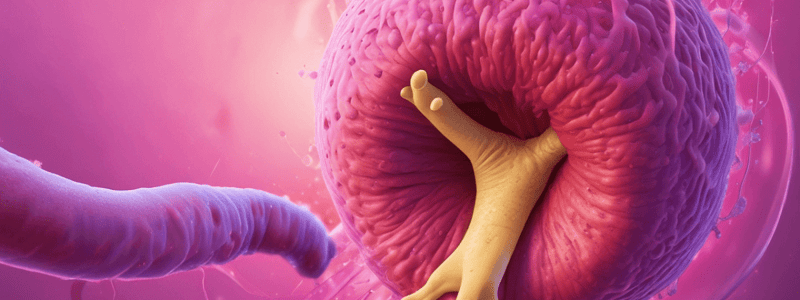Podcast
Questions and Answers
What is the typical timeframe for the development of secondary syphilis in adults after the appearance of the primary chancre?
What is the typical timeframe for the development of secondary syphilis in adults after the appearance of the primary chancre?
- 6-8 weeks (correct)
- 2-4 weeks
- 4-6 weeks
- 8-10 weeks
What is the characteristic rash associated with secondary syphilis?
What is the characteristic rash associated with secondary syphilis?
- Purpuric rash on the extremities
- Papular rash limited to the trunk
- Erythematous maculopapular rash over the entire body (correct)
- Vesicular rash on the palms and soles
What is the fate of the secondary syphilis lesions without treatment?
What is the fate of the secondary syphilis lesions without treatment?
- The lesions gradually worsen over time
- The lesions remain stable without treatment
- The lesions persist indefinitely
- The lesions regress without treatment (correct)
Which of the following is not a common symptom of secondary syphilis?
Which of the following is not a common symptom of secondary syphilis?
What is the histologic hallmark of the primary chancre in syphilis?
What is the histologic hallmark of the primary chancre in syphilis?
What is the most common age range for the development of secondary syphilis?
What is the most common age range for the development of secondary syphilis?
Which stage of syphilis is characterized by maculopapular lesions that cover most of the body?
Which stage of syphilis is characterized by maculopapular lesions that cover most of the body?
What is the causative agent of syphilis?
What is the causative agent of syphilis?
Why is Treponema pallidum not observable through conventional light microscopy?
Why is Treponema pallidum not observable through conventional light microscopy?
What is the most rapid method for visualizing Treponema pallidum?
What is the most rapid method for visualizing Treponema pallidum?
Which region of the body can exhibit condyloma lata in secondary syphilis?
Which region of the body can exhibit condyloma lata in secondary syphilis?
How do the lesions in secondary syphilis differ from childhood exanthems and infectious mononucleosis?
How do the lesions in secondary syphilis differ from childhood exanthems and infectious mononucleosis?
Which of the following statements about the maculopapular rash in infectious mononucleosis is correct?
Which of the following statements about the maculopapular rash in infectious mononucleosis is correct?
What percentage of patients with infectious mononucleosis typically develop petechiae on the hard and soft palates?
What percentage of patients with infectious mononucleosis typically develop petechiae on the hard and soft palates?
Which of the following statements regarding the maculopapular rash in infectious mononucleosis is true?
Which of the following statements regarding the maculopapular rash in infectious mononucleosis is true?
What percentage of patients with infectious mononucleosis develop a maculopapular rash?
What percentage of patients with infectious mononucleosis develop a maculopapular rash?
Which of the following statements about infectious mononucleosis is correct?
Which of the following statements about infectious mononucleosis is correct?
What percentage of patients with EBV mononucleosis treated with amoxicillin or ampicillin develop a maculopapular rash?
What percentage of patients with EBV mononucleosis treated with amoxicillin or ampicillin develop a maculopapular rash?
What is the characteristic rash associated with secondary syphilis?
What is the characteristic rash associated with secondary syphilis?
Which region of the body can exhibit condyloma lata in secondary syphilis?
Which region of the body can exhibit condyloma lata in secondary syphilis?
What is the fate of the secondary syphilis lesions without treatment?
What is the fate of the secondary syphilis lesions without treatment?
How do the lesions in secondary syphilis differ from those in infectious mononucleosis?
How do the lesions in secondary syphilis differ from those in infectious mononucleosis?
What is the most common age range for the development of secondary syphilis?
What is the most common age range for the development of secondary syphilis?
What is the histologic hallmark of the primary chancre in syphilis?
What is the histologic hallmark of the primary chancre in syphilis?
What causes the maculopapular rash in infectious mononucleosis?
What causes the maculopapular rash in infectious mononucleosis?
What percentage of patients with infectious mononucleosis typically develop a maculopapular rash?
What percentage of patients with infectious mononucleosis typically develop a maculopapular rash?
In which age group is the maculopapular rash more common in infectious mononucleosis?
In which age group is the maculopapular rash more common in infectious mononucleosis?
What percentage of patients with EBV mononucleosis treated with amoxicillin or ampicillin develop a maculopapular rash?
What percentage of patients with EBV mononucleosis treated with amoxicillin or ampicillin develop a maculopapular rash?
What is the characteristic appearance of the maculopapular rash in infectious mononucleosis?
What is the characteristic appearance of the maculopapular rash in infectious mononucleosis?
Which statement about the epidemiology of infectious mononucleosis is correct?
Which statement about the epidemiology of infectious mononucleosis is correct?
Which of the following best describes the characteristic maculopapular lesions in secondary syphilis?
Which of the following best describes the characteristic maculopapular lesions in secondary syphilis?
Which region can exhibit condyloma lata lesions in secondary syphilis?
Which region can exhibit condyloma lata lesions in secondary syphilis?
What is the causative organism of syphilis?
What is the causative organism of syphilis?
Why is darkfield microscopy useful for visualizing Treponema pallidum?
Why is darkfield microscopy useful for visualizing Treponema pallidum?
Which stage of syphilis is characterized by widespread maculopapular lesions covering most of the body?
Which stage of syphilis is characterized by widespread maculopapular lesions covering most of the body?
How do the lesions in secondary syphilis differ from those in childhood exanthems and infectious mononucleosis?
How do the lesions in secondary syphilis differ from those in childhood exanthems and infectious mononucleosis?
What is the most common rickettsial tick-borne infection in the United States?
What is the most common rickettsial tick-borne infection in the United States?
Which organism causes Rocky Mountain spotted fever?
Which organism causes Rocky Mountain spotted fever?
What is a unique manifestation of Rocky Mountain spotted fever?
What is a unique manifestation of Rocky Mountain spotted fever?
What is the typical timeframe for the development of symptoms after a tick bite in Rocky Mountain spotted fever?
What is the typical timeframe for the development of symptoms after a tick bite in Rocky Mountain spotted fever?
What can be a consequence of damage to the blood vessels in Rocky Mountain spotted fever?
What can be a consequence of damage to the blood vessels in Rocky Mountain spotted fever?
What is the most common symptom that occurs in the majority of Rocky Mountain spotted fever patients?
What is the most common symptom that occurs in the majority of Rocky Mountain spotted fever patients?
What is the most common cause of Toxic Shock Syndrome (TSS)?
What is the most common cause of Toxic Shock Syndrome (TSS)?
Which of the following is a key characteristic of Staphylococcal TSS?
Which of the following is a key characteristic of Staphylococcal TSS?
What is the primary reason for the prompt removal of attached ticks to prevent the transmission of Rocky Mountain Spotted Fever (RMSF)?
What is the primary reason for the prompt removal of attached ticks to prevent the transmission of Rocky Mountain Spotted Fever (RMSF)?
Which of the following is a key characteristic of Streptococcal Toxic Shock Syndrome (TSS)?
Which of the following is a key characteristic of Streptococcal Toxic Shock Syndrome (TSS)?
Which of the following is a risk factor for developing Toxic Shock Syndrome (TSS)?
Which of the following is a risk factor for developing Toxic Shock Syndrome (TSS)?
Which of the following is a key distinguishing feature of the rash in Staphylococcal Toxic Shock Syndrome (TSS) compared to other infectious diseases?
Which of the following is a key distinguishing feature of the rash in Staphylococcal Toxic Shock Syndrome (TSS) compared to other infectious diseases?
What is the primary cause of pathology in Rocky Mountain Spotted Fever (RMSF)?
What is the primary cause of pathology in Rocky Mountain Spotted Fever (RMSF)?
Which of the following is NOT a common laboratory finding suggestive of RMSF?
Which of the following is NOT a common laboratory finding suggestive of RMSF?
What is the recommended treatment for RMSF if there is a suspicion of the disease?
What is the recommended treatment for RMSF if there is a suspicion of the disease?
Which of the following is a method used for diagnosing RMSF?
Which of the following is a method used for diagnosing RMSF?
What is the characteristic rash seen in RMSF?
What is the characteristic rash seen in RMSF?
Which of the following is an important method of preventing RMSF?
Which of the following is an important method of preventing RMSF?




